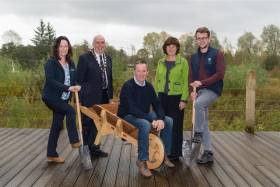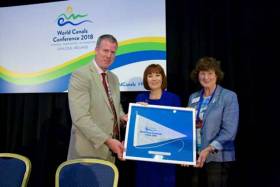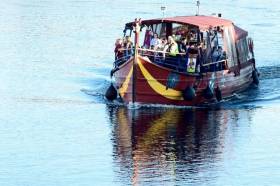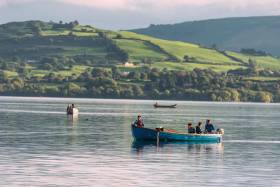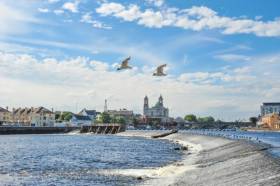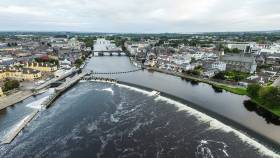Displaying items by tag: World Canals Conference
Handcrafted Tools Bring Royal Canal’s History to Life
#InlandWaters - Tools created by local Fermanagh craftsperson Albert Robinson were a key feature during this year’s World Canals Conference.
The tools, displayed in archive exhibition ‘Reflections, the Lasting Legacy of the Waterways’, brought to life the story of the strong men who powered the construction of Ireland’s canals system over 200 years ago.
Commissioned by the Directors General of Inland Navigation in 1813, the final section of the Royal Canal in Ireland to connect with the Shannon River was an extraordinary feat of ingenuity, engineering and sheer hard labour.
The contract to build the canal — complete with 21 locks, an aqueduct, 38 bridges, 40 tunnels, and numerous quays and harbours — was undertaken by Henry, Mullins and MacMahon in 1814 under the direction of the pre-eminent Irish engineer of that time, John Killaly.
Remarkably, that final section was completed within three short years at a cost of £198,110, covering a distance of some 24 1/2 miles.
What is most striking is that the tools available to the canal builders at this time, the world-famous ‘navvies’, were so basic.
Under the building contract, a detailed design specification was prepared for the manufacture of these tools to the company standard.
Local man Albert Robinson, a carpenter with Fermanagh and Omagh District Council, meticulously recreated these tools – a hand barrow and a wheelbarrow – using the specific wood types, elm for strength and ash for flexibility.
Patterson’s Spade Mills, owned and run by the National Trust, is the last remaining spade mill in daily use in Britain and Ireland. They, too, faithfully recreated objects from the original drawings, producing a spade and shovel.
The tools were on display throughout the World Canals Conference — which attracted over 320 delegates from 12 countries across three continents over its three days last month — and provoked much positive comment and requests for further displays of this quality work.
Commenting on the unique collection of handcrafted tools, Dawn Livingstone, chief executive of Waterways Ireland, said: “Working in partnership with Fermanagh & Omagh District Council and the National Trust, we have brought back to life a remarkable era of canal construction and created objects that tell the story of the men who built the amazing waterways that we continue to enjoy today.
“I commend the skill of the craftspeople involved from Fermanagh & Omagh District Council and Patterson's Spade Mill and would encourage visitors to see this extraordinary collection for themselves.”
Speaking about the exhibition, chairman of Fermanagh and Omagh District Council, Councillor Howard Thornton, said: “I am tremendously impressed by the craftsmanship shown by Albert in the recreation of the tools used in the construction of the final section of the Royal Canal.
“Albert’s ingenuity and craftsmanship have often been utilised in his work with Fermanagh and Omagh District Council and I am delighted that his talent has been showcased to a wider audience at such a prestigious event.”
Nathan Domer, visitor experience officer with the National Trust, added that “this type of project is at the forefront of our core aims as a charitable organisation to conserve our heritage on land and on water for all to enjoy for ever, for everyone."
The tools and the original blueprint drawings in the exhibition can be viewed at Waterways Ireland HQ at 2 Sligo Road, Enniskillen weekdays from 9.30am to 5.15pm till Friday 9 November.
World Canals Conference Attracts 320 Delegates to Athlone
Last week, Athlone Co Westmeath was the chosen venue for the 20 th World Canals Conference, co-hosted this year by the Inland Waterways Association of Ireland and Waterways Ireland. Speaking during the Conference, Inland Waterways International President David Edwards-May referred to Athlone as the spine of Ireland’s Inland Waterways. Mr Edwards-May also commended the co-hosts referring to the partnership between Waterways Ireland and the Inland Waterways Association of Ireland as a fine example of the state and voluntary sector working together.
The distinguished three-day international event brought together more than 320 delegates from a variety of backgrounds to celebrate, collaborate, appreciate and deliberate on the future of inland navigations and the challenges that they face. Up to 50 presentations were given over two days on themes including climate change, flood risk management, environmental sustainability, tourism development, restoration and canals heritage. In between papers, delegates enjoyed a day of technical tours that took in engineering, cultural and historical themes in the North, South and East of the country.
The Conference was opened by Minister for Culture Heritage and the Gaeltacht Josepha Madigan.
Speaking at the opening ceremony the Minister stated that ‘this gathering provides a unique opportunity for participants from all over the world to network, share ideas and experiences.’
Waterways Ireland Chief Executive Dawn Livingstone welcomed the Conference saying ‘The conference explores and celebrates the opportunities to reimagine our waterways in the 21st Century, to attract and sustain an ever-expanding number of users, to share best practice on how to lever value, to communicate with our users in the digital age and to protect the heritage and water supplies which is the fabric of our waterways.’
IWAI President John Dolan spoke of the great opportunity the Conference presented with so many professionals, superb academics and Canal enthusiasts from around the world, all ready to engage to learn and exchange experience and project information in relation to world-wide Canal projects. The Inland Waterways Association of Ireland are proud of their partnership with Waterways Ireland and Inland Waterways International to bring this Speaking on the theme of the Conference Restore - Regenerate – Re- imagine the President noted that while not losing sight of the opportunities Canals present as wet linear parklands that they are in fact mostly navigable waterways and that perspective must be a priority in their future development.
The closing address for this year’s Conference was given by President of Ireland, Michael D. Higgins who attended the ceremony with his wife Sabena. Speaking at length about the cultural, heritage and recreational opportunities the waterways have provided to generations of citizen and visitors President Higgins said ‘Canals and Waterways, if managed and re-imagined in a sustainable manner, can and will be at the centre of confronting the great challenges of our time’.
Commenting after President Higgins gave the closing address at the Conference; the IWAI President noted how successful the Conference had been citing the large amount of positive feedback from delegates. John also noted how appropriate it was that President Higgins has addressed the Conference given his passion for the Canals and the Inland Waterways and all the support he demonstrated as Minister for Arts Heritage and the Gaeltacht in the 1990s.
Have A Taste At The Athlone Shannon Feastival This Weekend
The Athlone Shannon Feastival this weekend 8-9 September expects to attract thousands of people to the Midlands town to take part in and enjoy the action packed lineup of activities on and off the Shannon and Lough Ree waterways.
This year's Feastival is the opening act to the World Canals Conference from 10 September, expected to attract over 400 delegates from all over the world to Athlone.
The Radisson Blu Festival Marquee, located at the walls of Athlone Castle, will be the hub for the festival, hosting workshops, talks, demos and kids’ entertainment.
The Feastival’s official launch event takes place on Saturday afternoon at 4pm when the Sheraton chefs will be busy shucking oysters to accompany Guinness from Sean’s Bar and jazz at the Feastival HQ.
Vikings are landing and will set up the Sheraton Viking Settlement at The Strand, where visitors can experience Viking life by exploring the medieval village and seeing weapon making, embroidery, medieval cooking and more.
On Saturday evening, local chefs sharpen their knives and wield their tongs for the Viking BBQ Cook-Off at 6pm, an event sure to satisfy the appetite.
On Sunday, why not treat yourself by visiting the Sirana Spa Wellness Area for some pampering? Or for a bit more action, watch the local crews as they battle it out to be crowned ‘Champions of The Shannon’ in the leisure boat rowing races.
Professional flyboarders take centre stage at 4pm as they hover over the river performing a variety of amazing stunts and tricks.
The Flogas Demo Kitchen hosts a series of foodie talks, cooking demos and tasty treats all afternoon. And at 6pm Viking Mike casts off and sets sail for a Viking whiskey cruise hosted by Midlands Whiskey Experiences.
Cafés and restaurants participating in the Feastival Food Trail all weekend include The Fatted Calf, Kin Khao, Thyme, Smoke BBQ, The Corner House Bistro, Fine Wine & Food Company, La Cucina Di Angelo, Radisson Blu Hotel, Hodson Bay Hotel, Sheraton Athlone Hotel and The Prince Bar, with more to be announced.
Fashion puts its best foot forwards at The Feastival Fashion Trail. Burgess department store hosts a series of workshops from 11:30am on Saturday with Kathryn Byrne of Your Image Matters, and Athlone Town Centre hosts a ‘Style Squad’ event with stylist Rebecca Rose and Tanya from the My Little Love Stories blog from noon to 4pm.
Meander the Music Trail around Athlone’s pubs featuring sessions at Sean’s Bar, The Snug, The Castle Inn, Fiddler’s Bar, The Malt House, Sheraton Athlone Hotel Bar, the Quayside Bar at the Radisson Blu Hotel, The Prince Bar, and the Waterfront Bar in the Hodson Bay Hotel.
The Artisan Food Village, open Saturday and Sunday, will showcase the best of locally produced food from producers including Kilbeggan Chocolate, Tara Jams, Wild Irish Foragers, KO Kombucha, Quarrymount Farm, Durrow Mills, Behan’s Fruit & Veg, Harvest Café, Radisson Blu Hotel, Prince of Wales Hotel and more.
Other highlights of the weekend include:
- Heritage boat spectacle and cruiser flotilla.
- Whiskey walking tours and tastings with Athlone Whiskey Tours.
- Performances by The Band of the 2nd Brigade and recitals of ‘Poetry in the Park’ at Athlone Castle.
- Free guided tours at selected times at Athlone Castle and Luan Gallery.
- ‘Reflections’, a special Waterways Ireland archive exhibition at Abbey Road Artist Studio and Luan Gallery.
“There’s a palpable air of enthusiasm around in advance of the Feastival,” said Athlone Chamber’s John McGrath. “And it’s great to see local businesses jumping on board and supporting the event in so many ways."
World Canals Conference Looks To China For Inspiration
#WCC - Zhu Minyang completes the list of keynote speakers at the upcoming World Canals Conference in Athlone next month.
Zhu has been the chair of the World Historical and Cultural Canal Cities Cooperation Organization (WCCO) since 2012, and has also served as party secretary of the city of Jiangyin and as mayor of Yangzhou, the ‘first city of the Grand Canal’.
Zhu personally participated in the selection of China’s Beijing–Hangzhou Grand Canal for the World Heritage List in 2014. He has extensive insights and experience in the development of Chinese social organisations and contemporary social governance.
Through his leadership, the WCCO has become a platform for economic and cultural exchanges focused on the world’s canal cities.
Zhu will address the conference on how the WCCO is supporting the renovation of China’s most famous canal. Through economic and ecological restoration and investment in heritage and cultural research, it is intended that a “human community with shared destiny” will develop to create deeper co-operation and regeneration opportunities for China’s canals.
Zhu Minyang will address the conference under its first theme, ‘Restore’, which calls for reflection on how 200-year-old man-made navigations remain relevant for people today.
Over the course of the conference, a variety of speakers from across Europe, Canada and the US will detail restoration works along their waterways as well as how they ensure that no heritage value is lost in these restorations.
John McKeown will speak on restoring the Royal Canal, Roger Squires will cover new approaches to restoration, while Pam Veinotte discusses evolving heritage assets to meet modern-day needs.
Restoration of the Shannon–Erne Waterway is the subject of Joseph Gillespie’s talk, while
Rudy Van der Ween talks the re-opening of the Lower Scheldt in the city centre of Ghent in Belgium, and Rob Vrojliks puts the focus on Limburg in the Netherlands and its regional masterplan approach.
From the US, William Holdsworth will explain how the Chesapeake & Ohio Canal Aqueduct restoration at Williamsport, Maryland brings history alive, while Theron Robson talks maintenance of heritage lock gates on the River Shannon, and Roger Alsater assays preservation efforts for the Göta Canal in Sweden.
‘Regenerate’ (focused on water management challenges) and ‘Reimagine’ (on engaging a wider audience with their local waterways) are the other two tracks at the World Canals Conference which begins in 37 days’ time. Details can be found on the World Canals Conference website.
President Michael D Higgins To Speak At World Canals Conference In Athlone This September
#InlandWaters - President of Ireland Michael D Higgins has been confirmed as a guest of honour at the World Canals Conference in Athlone this autumn.
“We are honoured that the President who throughout his career has demonstrated his commitment to and love of the inland waterways of Ireland, their history and culture, has agreed to speak at the conference and we look forward to hearing how he perceives the restoration, regeneration and reimagining of the waterways,” organisers said.
There are 53 days and counting till the three-day conference from 10-12 September at the Radisson Blu Hotel Athlone under the theme ‘restoring, regenerating, re-imagining’ — with various tours and sessions designed to inspire and connect delegates coming to the Midlands from all around the world.
These tours include an excursion around Lough Derg, the largest and most southerly lake on the River Shannon, that takes in the 1700s bridge linking Killable and Ballina as well as the Ardnacrusha hydroelectric plant, and will explore the challenges of doubling moorings along an old navigation.
Another technical tour will explore the North Shannon, Lough Allen Canal and the Shannon-Erne Waterway, with a stop at the Acres Lake floating boardwalk and a look at the marriage of modern and traditional locks at Kilclare.
As previously reported on Afloat.ie, the conference will be preceded by the three-day Shannon Athlone Feastival, highlighting local food producers in an exciting festival atmosphere with rowing, raft racing, a Viking village and demonstrations of flyboarding that wowed the crowds at the recent SeaFest in Galway.
Special rates for accommodation on board luxury cruise liners are still available, as are a range of exhibition opportunities for organisations looking to network with delegates. Details can be found on the World Canals Conference website.
#InlandWaters - Mike Palmer of the UK’s Waterway Recovery Group has been announced as a keynote speaker at the World Canals Conference in Athlone this September.
Chair of Britain’s national co-ordinating body for voluntary labour on inland waterways, Palmer will address the conference on the topic of ‘Waterways in Progress - the Waiting Gain’ — how restoration schemes are not just a means to an end, and can bring quantifiable benefits at every stage of their development.
Palmer is the latest of a growing list of keynote speakers to open the three-day conference at the Radisson Blu Hotel Athlone from Monday 10 to Wednesday 12 September under the theme ‘Restoring, regenerating, re-imagining’.
Delegates will also be welcomed by the two-day Shannon ‘Feastival’ on Saturday 8 and Sunday 9 September, with Athlone hosting boat tours to taste a range of food and crafts made by local artisans.
The deadline for early bird discounts has been extended to next Friday 15 June to benefit from up to 20% off the cost of registration.
Special prices are also available for accommodation on board a luxury hire cruiser before, during and after the conference, as previously reported on Afloat.ie.
Athlone To Host World Canals Conference Next September
#InlandWaters - Waterways Ireland and the Inland Waterways Association of Ireland will host the World Canals Conference 2018 in Athlone next September on the shores of Ireland’s longest waterway, the River Shannon.
‘Restoring, regenerating, re-imagining’ is the theme of the three-day conference from 10-12 September at the Radisson Blu Hotel Athlone that will feature various tours and sessions designed to inspire and connect delegates from all over the globe.
Register soon for to take advantage of the early bird rates ranging from €345 to €385. Some conference tours also have limited numbers so book early to secure your preferred tour and discount.
Special prices are also available for accommodation on board a luxury hire cruiser before, during and after the conference.
Cruisers can be booked for four to 14 nights, with four nights’ free mooring at the full service marina adjacent to the conference venue for the first 10 bookings.
For prospective conference speakers, the organisers are inviting abstract submissions till 28 February 2018 within the remit of the theme across the engineering, tourism, recreation, health and well-being, communications, technology, and arts and heritage sectors.
For more on the event, visit the World Canals Conference 2018 website or sign up for the newsletter for regular updates.




























